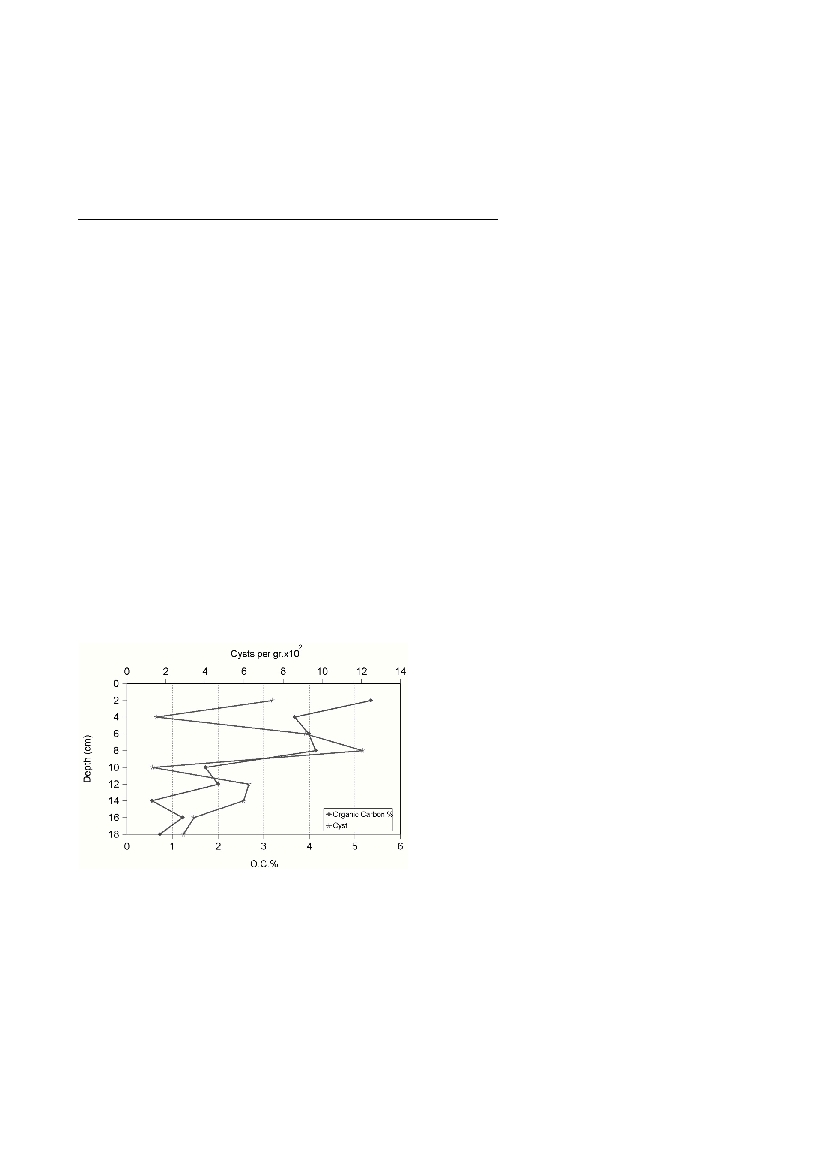Rapp. Comm. int. Mer Médit., 36,2001
392
The Eastern Harbour (E.H.) of Alexandria is a semicircular, semi-
closed bay, about 2.4 km in its greatest width. It is surrounded by the
City along its southern margin and communicates with the sea on its
northern side. The bay has always been the recipient of large volumes
of domestic waste water from several point sources. In 1996-1997,
however, all effluents but one were closed, the same volume of waste
water becoming disposed of through the remaining effluent on the
south-west bay margin. Since Halim (1), recurrent heavy blooms and
red tide outbreaks, caused mostly by Alexandrium minutumHalim,
have been documented and described (2, 3, 4, 5). After its toxic out-
break in 1994 (5), A. minutumappears to have become gradually
extinct, being replaced by several other potentially harmful species. Its
disappearance has been attributed by Ismael and Halim (6) to erosion-
al instability of the bottom sediments bearing its cysts and caused by
active hydrodynamic forcing. It should be mentioned that nothing is
known about sediment cysts from Egyptian waters.
Three 18 cm cores were collected from three equidistant stations
along the north-south axis of the bay.They were sliced into 2 cm frac-
tions, subjected to grain size analysis and their organic carbon content
determined. The fractions retained by the 20 µm sieve was sonicated
and microscopically examined.
We report here on core 1, collected immediately downstream from
the outfall, from the sink area. The lower layer of the core corresponds
to the year 1996-97, the year the outfall became fully functional, and
the upper most layer to the sampling year, 1999.
The organic carbon (OC) content increased from 0.9% to 5.4% at
the high average sedimentation rate of 6cm year
-1
. there is a clear cut
seasonal trend, the sinking rate accelerating during summer, the sea-
son of maximum sewage out?ow.Winter brings an apparent reversal
in the OC content, as the oxidation rate at the sediment-water interface
exceeds the rate of sewage deposition. The correlation between OC
content and grain size is significantly and negatively correlated.
Fig. 1. Organic carbone and dino?agellate cyste in core 1
There is a striking parallelism between the OC content and the strat-
ification of the dino?agellate cysts in the core. The profile of cyst
abundance is also seasonally clear cut, with an increased rate of cyst
deposition at the end of the summer blooming season followed by a
slow down in winter.Pyrophacus sp. cysts contributed 44% to the total
core, followed by Lingulodinium sp. (13%), Scrippsiella sp.(12.5%),
undetermined cyst 1 (12%), Alexandrium minutum(8%), undeter-
mined cyst 2 (7.6%) and Protoperidinium sp. (3%).
The stratification of A. minutumcysts appears to confirm the inter-
pretation of Ismael and Halim (6). While in the layers corresponding
to the years 1996-1997 and 1998, respectively, 40 to 125 and 20 to 120
cysts per gram were deposited, none were found in the layer corre-
sponding to 1999. This distribution is in agreement with the observed
disappearance of the species from the plankton.
References:
(1) Halim, Y., 1960. Alexandrium minutumn.g., n.s., dino?agelle
provocant des eaux rouges. Vie et Milieu, 11: 102-105.
(2) Sultan, H. A., 1975. Preliminary investigation in the primary
production of marine phytoplankton off the Mediterranean coast of
Alexandria region. M.Sc. Thesis, Faculty of Science, Alexandria
University, 151 pp.
(3) Zaghloul, F.A., 1988. Some physico-chemical indices of
eutrophication in the Eastern Harbour of Alexandria. Bulletin N.I.O.F.,
114(2): 39-53.
(4) Zaghloul, F.A. and Halim, Y., 1990. Phytoplankton ?ora and its
dynamics in the Eastern Harbour of Alexandria. Bull. High Inst. Public
Health. Alexandria, 20(4): 875-886.
(5) Labib, W. and Halim, Y., 1995. Diel vertical migration and toxicity of
Alexandrium minutum Halim red tide in Alexandria, Egypt. Mar. Life,
5(1): 11-17.
(6) Isamael, A. A. and Halim, Y., 2000. Occurrence and succession of
potentially harmful phytoplankton species in the Eastern Harbour of
Alexandria. Proceedings, Intern. Conf. on harmful algal blooms, 9
th
Conf., Tasmania 2000, Hallegraeff G. (ed.).
DINOFLAGELLATE CYSTS FROM THE SEDIMENTS
OF THE EUTROPHIC EASTERN HARBOUR OF ALEXANDRIA, EGYPT
A.A. Ismael, A. M. Khadr and Y. Halim
Department of Oceanography, Faculty of Science, Alexandria, Egypt
Abstract
A sediment core from the eutrophic zone of the Eastern Harbour of Alexandria is examined for organic carbon content, grain size and
dino?agellate cysts. The rate of sediment deposition is abnormally high in the sink area of downstream from the outfall, but there is an
obvious seasonal trend. Cyst deposition follows a parallel trend, accelerating by the end of summer.Pyrophacus sp. cyst are dominant in
the core. The stratification of A. minutum cysts confirms its observed disappearance from the plankton.
Key words: Alexandria. Dino?agellate cysts. Eutrophication. Alexandrium minutum

